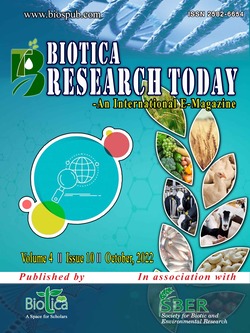
Nano Clay Polymer Composites - A Potential Control Delivery System for Nutrients and Agrochemicals
Shaon Kumar Das*
ICAR-Research Complex for NEH Region, Sikkim Centre, Tadong, Gangtok, Sikkim (737 102), India
Aniruddha Roy
Dr. Rajendra Prasad Central Agricultural University, Pusa, Samastipur, Bihar (848 125), India
Ezekiel K. Bhujel
ICAR-Research Complex for NEH Region, Sikkim Centre, Tadong, Gangtok, Sikkim (737 102), India
R. Laha
ICAR-Research Complex for NEH Region, Sikkim Centre, Tadong, Gangtok, Sikkim (737 102), India
V.K. Mishra
ICAR-Research Complex for NEH Region, Umiam, Meghalaya (793 103), India
DOI: NIL
Keywords: Agrochemicals, Controlled release, Nanoclay polymer composites, Nutrients
Abstract
Nanoclays are nanoparticles containing layered mineral silicates. Polymer composites are a combination of polymers (i.e., thermosets or thermoplastics) with various continuous and non-continuous reinforcements/ fillers, principally added to polymers to improve the material performance. Nanoclays are recently being used for preparation of polymer/ clay super-absorbent composite formulation resulting lower production cost, excellent water retention and considerable applications in agriculture and horticulture. Conventional super-absorbent network synthesized from polymers such as poly sodium acrylate and polyacrylamide often poses limitation owing to poor biodegradability under natural environmental condition and restricts its wider use. Synthesis and formulation of novel biodegradable molecules with intelligent delivery system are being attempted in recent times. Nanoclay polymer composite (NCPC) based fertilizer and pesticide formulation with controlled release property has been reported worldwide. Such formulations might have good potential for agricultural use as controlled release fertilizer or agrochemicals formulation. However, it needs to be evaluated in long-term experiment in various soil types and cropping system for evaluating benefit: cost ratio and wide scale farmers’ adaptability.
Downloads
not found
Reference
Barman, H., Das, S.K., Roy, A., 2018. Future of Nano science in Technology for Prosperity: A Policy Paper. Nanoscience and Technology 5(1), 1-5.
Das, S.K., Ghosh, G.K., 2021. Development and evaluation of biochar based secondary and micronutrient enriched slow-release nano-fertilizer for reduced nutrient losses. Biomass Conversion and Biorefinery. DOI: 10.1007/s13399-021-01880-5.
Das, S.K., Ghosh, G.K., Mukherjee, I., Avasthe, R.K., 2017. Nano-science for Agrochemicals in Plant Protection. Popular Kheti 5(4), 173-175.
Guo, F., Aryana, S., Han, Y., Jiao, Y., 2018. A review of the synthesis and applications of polymer-nanoclay composites. Applied Science 8, 1-29. DOI: 10.3390/app8091696.
Merino, D., Tomadoni, B., Salcedo, M.F., Mansilla, A.Y., Casalongué, C.A., 2020. Handbook of Nanomaterials and Nanocomposites for Energy and Environmental Applications. Handb. Nanomater. Nanocomposites Energy Environ. Appl. DOI: 10.1007/978-3-030-11155-7.
